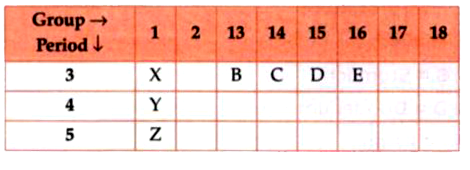An element lies In third period and second group of the periodic table. Select the false statement about the atom of this element.
A
It has three valence electrons
B
It has three shells
C
It has two valence electrons
D
It has 12 electrons
Video Solution
Text Solution
The correct Answer is:A
It has three valence electrons
|
Updated on:21/07/2023
Topper's Solved these Questions
- BOOK - OSWAL PUBLICATIONCHAPTER - DIKSHA QUESTIONS EXERCISE - PERIODIC CLASSIFICATION OF ELEMENTS (LONG ANSWER)30videos
DIKSHA QUESTIONS
- BOOK - OSWAL PUBLICATIONCHAPTER - CHEMICAL REACTIONS AND EQUATIONSEXERCISE - CASE-BASED MCQs29videos
CHEMICAL REACTIONS AND EQUATIONS
- BOOK - OSWAL PUBLICATIONCHAPTER - METALS AND NON - METALS EXERCISE - CASE - BASED MCQs29videos
METALS AND NON - METALS
Similar Questions
Knowledge Check
- Question 1 - Select One
An element which lies in the same group of the periodic table as mercury is
AcadmiumBgoldCtinDthallium - Question 2 - Select One

An element 'X' belongs to the third period and group 16 of the periodic table. Find out the valency of X?AValency = 0BValency = 2CValency = 1DValency = 3 - Question 3 - Select One
Number of elements in the second period of the periodic table is -
AeighteenBeightCtwoDten
The elements of same group of the periodic table have
View SolutionAn element which belongs to third period and group 16 in the periodic table has electronic configuration
View SolutionA particular element belongs to group 13 and second period of the periodic table, it is
View SolutionAn element belongs to third period and group 13 of the periodic table which of the following properties will be shown by the element?
View SolutionElements of group 17 of the periodic table are called
View Solution
